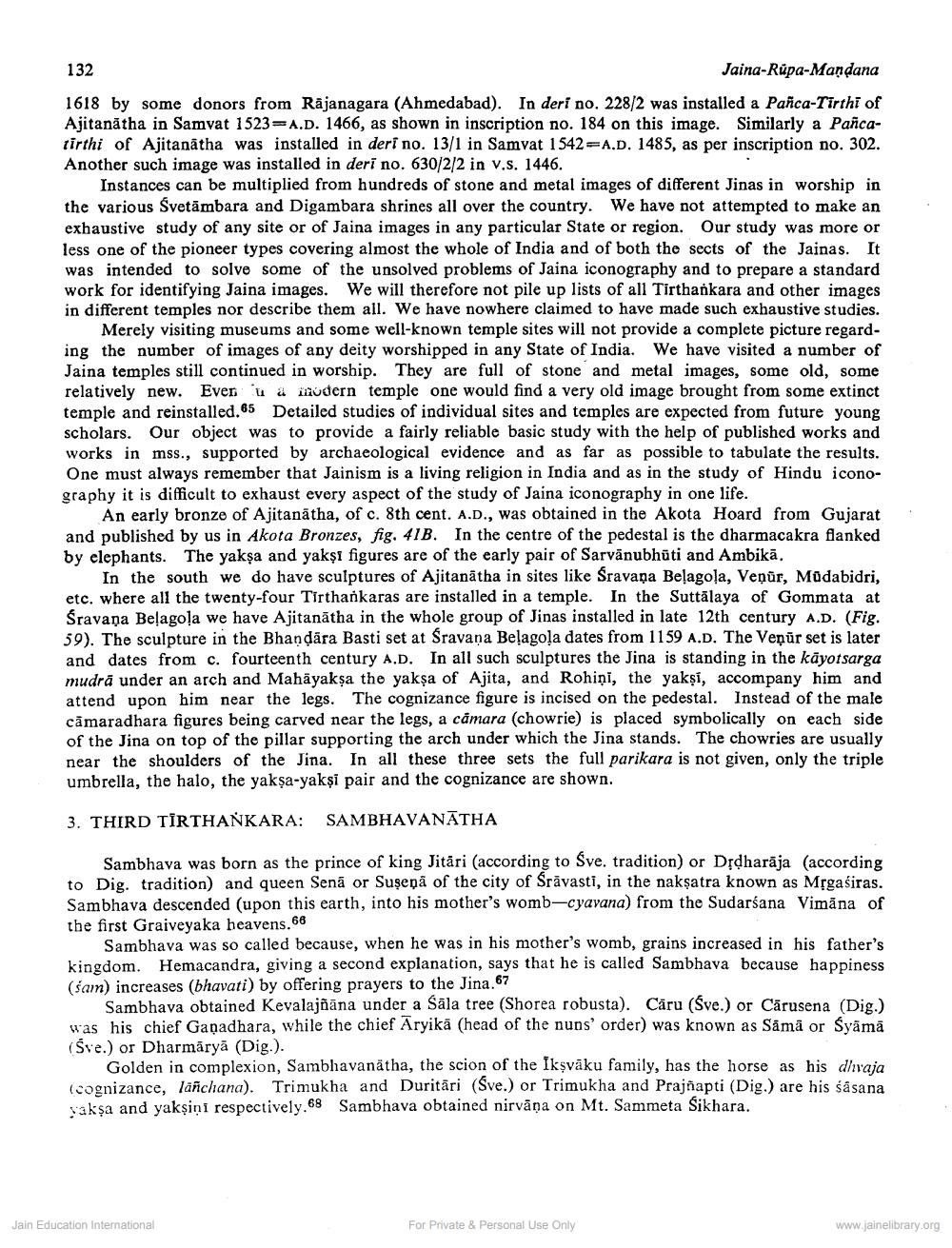________________
132
Jaina-Rupa-Mandana 1618 by some donors from Rājanagara (Ahmedabad). In deri no. 228/2 was installed a Panca-Tīrthi of Ajitanātha in Samvat 1523 A.D. 1466, as shown in inscription no. 184 on this image. Similarly a Pancatirthi of Ajitanātha was installed in deri no. 13/1 in Samvat 1542=A.D. 1485, as per inscription no. 302. Another such image was installed in deri no. 630/2/2 in v.s. 1446.
Instances can be multiplied from hundreds of stone and metal images of different Jinas in worship in the various Svetāmbara and Digambara shrines all over the country. We have not attempted to make an exhaustive study of any site or of Jaina images in any particular State or region. Our study was more or less one of the pioneer types covering almost the whole of India and of both the sects of the Jainas. It was intended to solve some of the unsolved problems of Jaina iconography and to prepare a standard work for identifying Jaina images. We will therefore not pile up lists of all Tirthankara and other images in different temples nor describe them all. We have nowhere claimed to have made such exhaustive studies.
Merely visiting museums and some well-known temple sites will not provide a complete picture regarding the number of images of any deity worshipped in any State of India. We have visited a number of Jaina temples still continued in worship. They are full of stone and metal images, some old, some relatively new. Even tå fodern temple one would find a very old image brought from some extinct temple and reinstalled. 65 Detailed studies of individual sites and temples are expected from future young scholars. Our object was to provide a fairly reliable basic study with the help of published works and works in mss., supported by archaeological evidence and as far as possible to tabulate the results. One must always remember that Jainism is a living religion in India and as in the study of Hindu iconography it is difficult to exhaust every aspect of the study of Jaina iconography in one life.
An early bronze of Ajitanatha, of c. 8th cent. A.D., was obtained in the Akota Hoard from Gujarat and published by us in Akota Bronzes, fig. 41B. In the centre of the pedestal is the dharmacakra flanked by elephants. The yaksa and yakşi figures are of the early pair of Sarvänubhūti and Ambikā.
In the south we do have sculptures of Ajitanātha in sites like Sravana Belagola, Veņūr, Müdabidri, etc. where all the twenty-four Tirthařkaras are installed in a temple. In the Suttālaya of Gommata at Śravana Belagola we have Ajitanātha in the whole group of Jinas installed in late 12th century A.D. (Fig. 59). The sculpture in the Bhandara Basti set at Sravana Belagola dates from 1159 A.D. The Venur set is later and dates from c. fourteenth century A.D. In all such sculptures the Jina is standing in the kāyotsarga mudra under an arch and Mahāyaksa the yakşa of Ajita, and Rohini, the yaksi, accompany him and attend upon him near the legs. The cognizance figure is incised on the pedestal. Instead of the male câmaradhara figures being carved near the legs, a cámara (chowrie) is placed symbolically on each side of the Jina on top of the pillar supporting the arch under which the Jina stands. The chowries are usually near the shoulders of the Jina. In all these three sets the full parikara is not given, only the triple umbrella, the halo, the yakşa-yakşi pair and the cognizance are shown.
3. THIRD TIRTHANKARA: SAMBHAVANATHA
Sambhava was born as the prince of king Jitāri (according to Sve. tradition) or DỊdharāja (according to Dig. tradition) and queen Senā or Suşeņa of the city of Srāvasti, in the nakşatra known as Mrgaśiras. Sambhava descended (upon this earth, into his mother's womb-cyavana) from the Sudarśana Vimāna of the first Graiveyaka heavens.66
Sambhava was so called because, when he was in his mother's womb, grains increased in his father's kingdom. Hemacandra, giving a second explanation, says that he is called Sambhava because happiness (sam) increases (bhavati) by offering prayers to the Jina.67
Sambhava obtained Kevalajñāna under a Sāla tree (Shorea robusta). Cāru (Sve.) or Cärusena (Dig.) was his chief Ganadhara, while the chief Aryikā (head of the nuns' order) was known as Sämä or Syāmā (Sve.) or Dharmāryā (Dig.).
Golden in complexion, Sambhavanatha, the scion of the Ikşvāku family, has the horse as his diraja (cognizance, lanchana). Trimukha and Duritāri (Sve.) or Trimukha and Prajnapti (Dig.) are his sasana Yaksa and yaksini respectively.68 Sambhava obtained nirvāṇa on Mt. Sammeta Sikhara.
Jain Education International
For Private & Personal Use Only
www.jainelibrary.org




